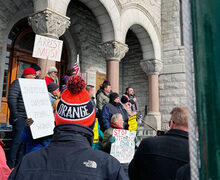This is what black student leadership looks like in 2017
Casey Russell | Feature Editor
Jahnessa Payne and Justine Thompson are co-coordinators with Kalabash Dance Troupe.
Editor’s note: In light of Black History Month, this story and “This is what black student leadership looked like in 1968” examine black student leadership in the 1960s and today.
Though Charles Hicks was the heavy-hitter for black leadership on campus during the peak of the Civil Rights Movement in the ‘60s, student life on campus is just as vibrant now as it was back then.
The Office of Multicultural affairs lists more than 20 organizations active today that work with students of color across all disciplines. Coordinator of Student Engagement Cedric Bolton has been working with groups — academic or performance-based — for 13 years. He serves as an adviser and liaison for most of the student groups he works with, but he also said students really shine on their own.

Graphic illustration by Kiran Ramsey
One of those students includes Jahnessa Payne, a junior bioengineering major. She is a co-coordinator with Kalabash Dance Troupe, and Black History Month is one big celebration of the diversity within black culture in the United States.
“It’s a great platform for us to get recognition for all of our contributions to the U.S.,” Payne said.
Black leadership on campus now is very strong, she added. Organizations work tirelessly and take their work very seriously, creating a positive and creative community for students of color on campus.
Dominic Samuels is president of one of Syracuse’s five historically-black fraternities: Phi Beta Sigma. A junior information management and technology major, he is also part of the Alpha Kappa Psi professional business fraternity. He said he’s glad Black History Month gives students on campus an opportunity to explore their culture and reflect on what their history and culture means to them.
“It’s about the students on campus too,” Samuels said. “Giving them the opportunity to get involved in different black events and make them feel a part of the culture on campus.”
For Alseny Frederick, a senior public health major and member of Phi Beta Sigma, Black History Month is a time to remember those that came before him and the sacrifices they made.
“It’s just a time to look at where we are now and just notice how far we’ve come,” Frederick said. “It just makes me feel like I have to grind and do what I got to do to continue be successful and continue to be a role model for younger black people.”
Fredericks and Samuels both said that black leadership on campus is “passionate” and “powerful.”
“We have a lot of powerful individuals on campus,” Samuels said.
Black campus leaders including Cedric Bolton have been working hard, especially this week, coordinating a calendar of events for Black History Month 2017. This year, the Office of Multicultural Affairs has lined up 21 events including guest speakers, art exhibitions, musical performances, banquets and even a dance-a-thon benefit.
In addition to the events listed as official events on the Black History Month 2017 calendar, student groups are having their own events as well. Kalabash Dance Troupe is having a workshop on Friday where participants can try out all sorts of different styles of dance and costumes.
“I can’t even name them all,” said Frederick, president of the National Panhellenic Council, about Black History Month events on campus.
Black History Month may be a special time for students of color on the Syracuse campus, but at the end of the day, these groups are there to serve the student body, Bolton said. They unify and engage all members of the African diaspora in an inclusive environment. Bolton described this campus’s black student leaders as “active” and “in-tune.”
“They have a pulse on what’s going going on,” he said. “They are great leaders.”
Published on January 31, 2017 at 10:57 pm
Contact: cmrussel@syr.edu | @caseymrussell





